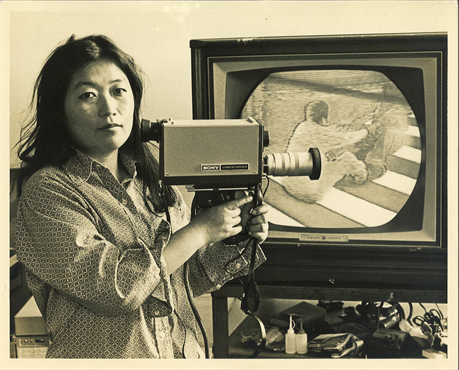June 29-September 23, 2021
This exhibition will be the first major survey of the art of Shigeko Kubota (1937 - 2015) in Japan nearly in three decades. Born in Niigata and educated in Tokyo, Kubota moved to New York in 1964 to join the Fluxus movement. In the 1970s she became internationally known as a pioneering artist for her "video sculpture," which integrated video into three-dimensional structures. Her contribution to contemporary art, however, has yet to be adequately evaluated.
The Viva Video! exhibition provides a survey of Japanese American female artist Shigeko Kubota, with the latest research in context for international audiences. Shortly after the artist's passing in 2015, the Shigeko Kubota Video Art Foundation was established in New York at the bequest of the artist to preserve and further study of Kubota's life and legacy, in addition to advancing the field of video art. Drawing significantly from the collection of recently restored sculptures, drawings, photographs, and ephemera of the Shigeko Kubota Video Art Foundation, and complementing them with additional works from Japanese museums and archival materials from the artist's family, the exhibition will showcase a diverse array of materials for the first time.
What was Kubota thinking and seeking as a woman artist who was developing her art on the world stage in the dawn of media art? The exhibition will present multivalent views of Kubota's life and work, through drawings, photographs, archival documents, video, including her Duchampiana video sculpture series. The exhibition is scheduled to tour three museums across Japan, starting in Niigata, her hometown, in spring 2021, traveling to Osaka in summer, and ending in Tokyo in February 2022.
Grant support: Terra Foundation for American Art, Japan Agency for Cultural Affairs; The Pola Art Foundation; The Mitsubishi UFJ Trust and Regional Culture Foundation (Niigata only); The Nomura Foundation (Niigata only).
"The Terra Foundation for American Art is dedicated to fostering exploration, understanding, and enjoyment of the visual arts of the United States for national and international audiences. Recognizing the importance of experiencing original works of art, the foundation provides opportunities for interaction and study, beginning with the presentation and growth of its own art collection in Chicago. To further cross-cultural dialogue on American art, the foundation supports and collaborates on innovative exhibitions, research, and educational programs.
Implicit in such activities is the belief that art has the potential both to distinguish cultures and to unite them."

Shigeko Kubota Portrait © Tom Haar, 1972 Courtesy of Tom Haar and Shigeko Kubota Video Art Foundation